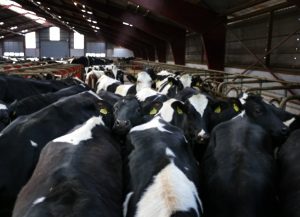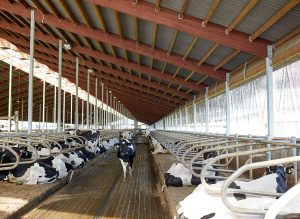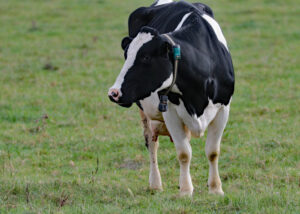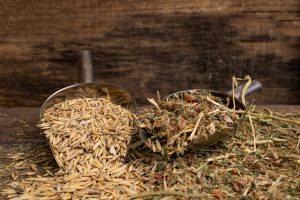María Villagrasa & Nuria García
Measurements of different physiological or behavioral indicators are often used to assess animal well-being and how animals face their environment.
Vocalizations in addition to containing biological information of different types such as the individual identity of the emitter, age, sex or state of motivation, may vary in its structure depending on the stress of the emitter. Therefore, vocal parameters could be an objective and non-invasive alternative to traditional animal well-being indicators.
Cattle are known to respond vocally, physically and psychologically to stressful events. One clear example is that of the separation of the cow and the newborn calf. With her calf the cow shows maternal behaviors such as smelling and licking, along with vocalizations that facilitate the recognition of the calf and that possibly reflect positive emotions. In contrast, the separation of its calf is characterized by intense negative activation that causes strong behavioral and physiological reactions in the cow.
These two different postpartum contexts can therefore produce predictable changes in vocalization and provide a good model for studying them as they relate to livestock well-being.
In order to provide more data on this topic, a group of researchers conducted a study at the University of Sydney (Australia; Green et al., 2020) to evaluate the emotional content of the vocalizations emitted by cows after calving while interacting with their young, and then after their separation. The type of call and their structure were also analyzed.
Recorded were 60 minutes of interactions of 23 Holstein-Friesian cows with their calves shortly after delivery, once the cow had free access to its calf, and another 60 minutes after their separation once the farmer moved the calf to another pen separated by a fence. The fence allowed both the cow and calf to maintain eye, auditory and physical contacts, with cows sometimes licking the calf by stretching their necks over the fence or placing their heads through the bars.
The behaviors analyzed were: touching the calf, being alert towards the calf, vocalizations with closed mouth, open mouth, and mixed, approaching the fence and interacting with the fence (the cow presses the muzzle against the fence or puts its head on the bars).
Cow vocalizations and post-calving behavior
During the interactions with the offspring, the most common behavior expressed by cows was closed-mouth vocalizations (53.6%), followed by touching the calf (19.2%), alert (16.9%), open-mouth calls (5.60%), and mixed (4.70%). On the contrary, during separation, the alert towards the calf was the most frequent behavior (26. 1%), followed by closed-mouth calls (24.1%), approaching the fence (18.5%), open-mouth vocalization (12.0%), interactions with the fence (9.90%), and mixed calls (9.4%).
Cow behavior next to their calves
During interaction with the calves, cow behavioral patterns varied depending on their location. When she distanced herself from the calf, before any contact the cow repeatedly issued mixed calls. This was transformed into open-mouth vocalizations that were repeated and then they went on to touch the calf. After approaching and touching the calf, the cow proceeded to vocalize with its mouth closed continuously, acting as an end point to this behavior.
Behavior of cows separated from their calves
During the separation of the calf, cows expressed an escalation of stress responses, starting by approaching the fence and being alert. Afterwards, they issued closed-mouth or mixed calls. Mixed calls were repeated and then became open-mouth calls. Closed-mouth calls gave way to interactions with the fence: cows remained close to it or returned to this position after emitting closed-mouth, mixed, open-mouth vocalizations. The alert behavior towards the calf was followed in addition by the cow approaching the fence.
Cow vocalizations after separation from calves’ manifest stress
These results considered together show that there is a changing temporal relationship between vocalizations and behaviors in the two contexts.
Unlike the situation during interaction with the calf, where closed-mouth calls were the end point of the behavior, vocalizations during separation were followed by interactions with the fence. This change highlights the general alteration of maternal behavior and increased stress caused by separation.
In both postpartum contexts, closed-mouth calls operated mainly in short-distance communications, with the calf being the intended receiver of the signal. By sniffing and licking the calf, the cows issued these calls to constantly indicate positive social behavior towards the calf. During separation, repeated closed-mouth calls resulted in recurring interactions on the fence, including muzzle pressure on the bars and extension of the head to touch the calf, further highlighting the positive emotional expression of these calls when seeking some contact with the calf.
Mixed calls, which were emitted during times of greater unease than their closed-mouth counterparts, represented the intermediate form of low- and high-frequency calls commonly reported in the literature. The significant transition from mixed calls, containing open-mouth and closed-mouth components to open-mouth calls, complements the idea that cattle show a gradual vocal repertoire that reflects a continuity in the emotional expression of cows during both postpartum contexts.
The observation of mixed or open-mouth calls of cattle in the field after a brief visual separation from their calves, suggests that these calls could be a way to express emotions, as a greater concern when cows separate themselves from their calves. In fact, open-mouth calls were generally more common during calves’ separation, while interactions between calves produced more closed-mouth calls.
Structure of cow vocalizations
Some of the measured vocal parameters differed according to the context after calving:
- During interactions with the calf, cows issued more low-frequency closed-mouth calls (149.6 vs. 84.3; interaction vs. separation), while during separation from the offspring, mixed and high-frequency calls were more prevalent (5.99 vs. 23.1; interaction vs. separation).
- Cows issued more isolated calls during interactions with their offspring than during their separation (in proportion 0.96 vs. 0.92).
- The time between separate call sequences was longer for interactions with calves than during separation (7.59 vs. 5.93 seconds).
- The vocal sequences contained a greater number of individual vocalization units during calf separation (2.95 vs. 2.42).
Thus, the higher percentage of vocal sequences (the opposite of isolated calls), of call sequenced vocal units, and a shorter interval between call sequences during separation suggest the existence of an activation or alert state on the part of the cow reflecting the alarm caused by the situation.
Conclusions
Separation from its calf is a stressful situation for the cow compared to the normal interactions it performs with her offspring, leading to a higher percentage of mixed and open-mouth vocalizations, a higher percentage of vocal sequences, a greater number of vocal units per sequence, and a shorter interval between call sequences.
Knowledge of this information would serve to alleviate well-being problems on dairy farms by implementing different methods to separate animals.
Reference
Green, Alexandra & Lidfors, Lena & Lomax, Sabrina & Favaro, Livio & Clark, Cameron. (2021). Vocal production in postpartum dairy cows: Temporal organization and association with maternal and stress behaviors. Journal of Dairy Science. 104. 10.3168/jds.2020-18891.
© 2021 Dellait Dairy Knowledge Center. All Rights Reserved.









